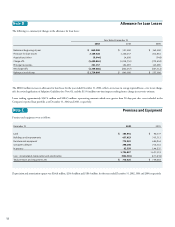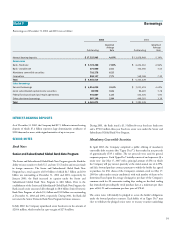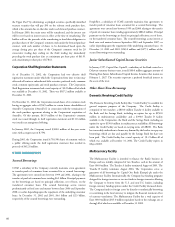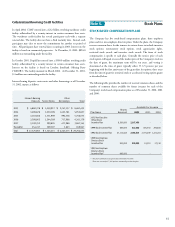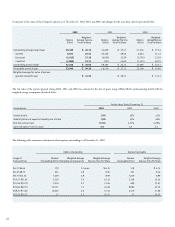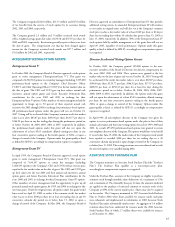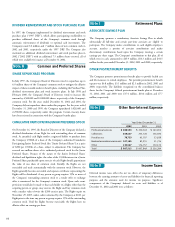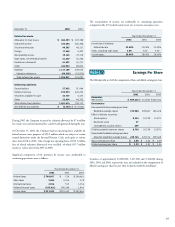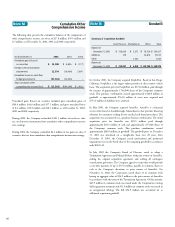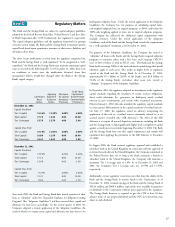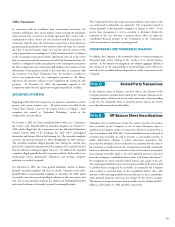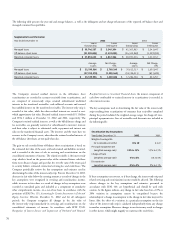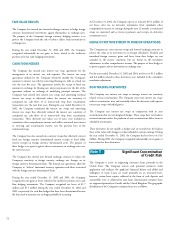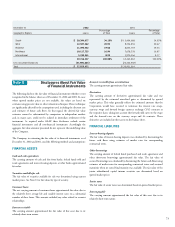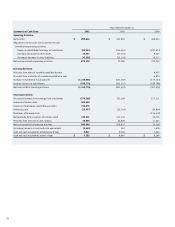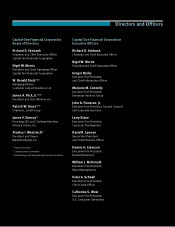Capital One 2002 Annual Report Download - page 70
Download and view the complete annual report
Please find page 70 of the 2002 Capital One annual report below. You can navigate through the pages in the report by either clicking on the pages listed below, or by using the keyword search tool below to find specific information within the annual report.
68
GUARANTEES
Residual Value Guarantees
The Company has entered into synthetic lease transactions to finance several
facilities. A synthetic lease structure typically involves establishing a special
purpose vehicle (“SPV”) that owns the properties to be leased. The SPV is
funded and its equity is held by outside investors, and as a result, neither the
debt of nor the properties owned by the SPV have been included in the
accompanying consolidated financial statements. These transactions, as
described below, are accounted for as operating leases in accordance with
SFAS No. 13, Accounting for Leases. The Company has entered into
maximum residual value guarantee agreements with the lessors of the
Note P Commitments, Contingencies
and Guarantees
LINE OF CREDIT COMMITMENTS
As of December 31, 2002 the Company had outstanding lines of credit of
approximately $165.5 billion committed to its customers. Of that total
commitment, approximately $105.8 billion was unused. While this amount
represented the total available lines of credit to customers, the Company has
not experienced, and does not anticipate, that all of its customers will exercise
their entire available line at any given point in time. The Company generally
has the right to increase, reduce, cancel, alter or amend the terms of these
available lines of credit at any time.
LEASE COMMITMENTS
Certain premises and equipment have been leased under agreements that
expire at various dates through 2012, without taking into consideration
available renewal options. Many of these leases provide for payment by the
lessee of property taxes, insurance premiums, cost of maintenance and other
costs. In some cases, rentals are subject to increase in relation to a cost of
living index. Total rent expenses amounted to approximately $63.2 million,
$64.7 million and $66.1 million for the years ended December 31, 2002,
2001 and 2000, respectively.
Future minimum rental commitments as of December 31, 2002, for all non-
cancelable operating leases with initial or remaining terms of one year or
more are as follows:
2003 $ 62,676
2004 44,650
2005 40,223
2006 35,502
2007 34,918
Thereafter 84,469
Total $ 302,438
properties (the SPVs established in the lease structures), whereby the
Company guarantees certain residual amounts to the lessors in the event of a
sale of the property or expiration of the lease. The amount of the deficiency is
recognized as rent expense on a straight-line basis over the remaining term of
the lease. The accrual for a deficiency is required regardless of whether the
Company expects to exercise a purchase option or renewal option at the end
of the lease term.
In December 2000, the Company entered into a 10-year agreement for the
lease of a headquarters building being constructed in McLean, Virginia. The
agreement calls for monthly rent to commence upon completion, which is
expected to occur in the first quarter of 2003, and is based on LIBOR rates
applied to the cost of the buildings funded. If, at the end of the lease term,
the Company does not purchase the property, the Company guarantees a
maximum residual value of up to $114.8 million representing approximately
72% of the estimated $159.5 million cost of the buildings in the lease
agreement. This agreement, made with a multi-purpose entity that is a
wholly-owned subsidiary of one of the Company’s lenders, provides that in
the event of a sale of the property, the Company’s obligation would be equal
to the sum of all amounts owed by the Company under a note issuance made
in connection with the lease inception. As of December 31, 2002, the
estimated cost of the building provided a reasonable approximation of the
fair value, and thus no deficiency existed and no liability related to the
maximum residual value guarantee was recorded relative to this property.
In 1999, the Company entered into two three-year agreements for the
construction and subsequent lease of four facilities located in Tampa, Florida
and Federal Way, Washington. The construction of all four of these facilities
was completed during 2001. The total cost of the buildings was
approximately $98.8 million. Monthly rent commenced upon completion of
each of the buildings and is based on LIBOR rates applied to the cost of the
facilities funded. The Company had one-year renewal options under the
terms of each of the leases, which were exercised during 2002 to extend the
life of the leases through September of 2003. If, at the end of the lease terms,
the Company does not purchase all of the properties, the Company
guarantees a maximum residual value to the lessor of up to $84.0 million
representing approximately 85% of the cost of the buildings in the lease
agreement. During the fourth quarter, the estimated fair value of the facilities
fell to a level below the maximum residual value guaranteed resulting in a
deficiency of $22.0 million. Correspondingly, the Company has recognized
$11.2 million as additional rent expense related to the deficiency as of
December 31, 2002.
In 1998, the Company entered into a five-year lease of five facilities in
Tampa, Florida and Richmond, Virginia. Monthly rent on the facilities is
based on a fixed interest rate of 6.87% per annum applied to the cost of the
buildings included in the lease of $86.8 million. The Company has two one-
year renewal options under the terms of the lease, which have been exercised
to extend the life of the lease through December of 2005. If, at the end of the
lease term, the Company does not purchase all of the properties, the
Company guarantees a maximum residual value to the lessor of up to $72.9
million representing approximately 84% of the costs of the buildings in the
lease agreement. As of December 31, 2002, the estimated fair value of the
facilities fell to a level below the maximum residual value guaranteed resulting
in a deficiency of $13.0 million. Correspondingly, the Company recognized
$.4 million as additional rent expense related to the deficiency as of
December 31, 2002.


